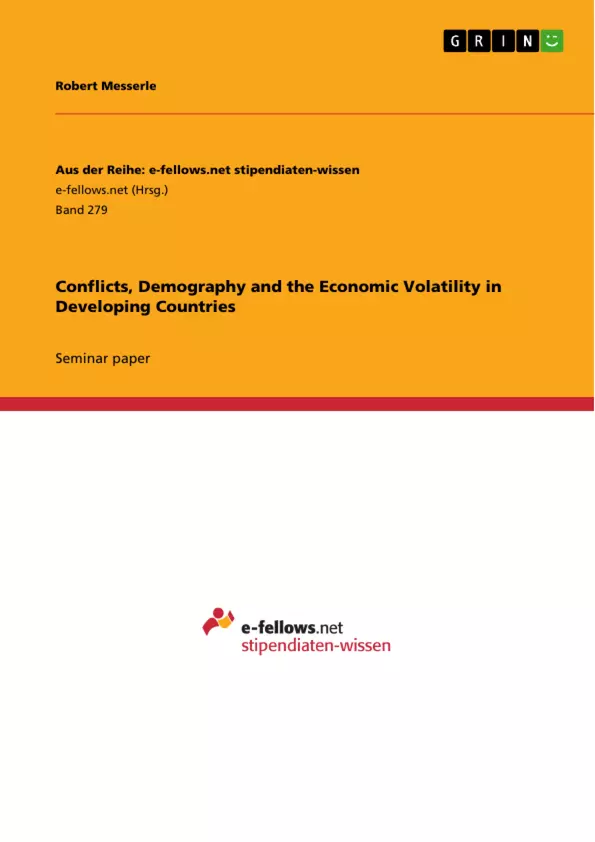“In cities in six West African countries I saw similar young men everywhere--hordes of them. They were like loose molecules in a very unstable social fluid, a fluid that was clearly on the verge of igniting.” (Kaplan, 1994)
With his article “The Coming Anarchy” Kaplan ignited a discussion over the threat posed by youth cohorts to the civilized world. More than 15 years later there is still no clear evidence whether large populations of young men are a main factor in determining conflict risk or not. This paper now tries to connect the topic of demographically induced violence with another contemporary topic of development economics: growth volatility.
Inhaltsverzeichnis (Table of Contents)
- INTRODUCTION
- LITERATURE REVIEW
- DEMOGRAPHIC VARIABLES AND CONFLICT
- GROWTH VOLATILITY, CONFLICT AND YOUTH DEPENDENCY
- CONCLUSION
Zielsetzung und Themenschwerpunkte (Objectives and Key Themes)
This paper examines the connection between demographically induced violence and economic growth volatility, specifically focusing on the impact of large youth populations on conflict risk and economic instability in developing countries.
- The relationship between youth cohorts and conflict risk
- The impact of demographic factors on economic growth volatility
- The influence of youth dependency on economic instability
- The role of institutions and governance in economic development and stability
- The comparison of economic growth patterns across regions
Zusammenfassung der Kapitel (Chapter Summaries)
- INTRODUCTION: The chapter sets the context by discussing Kaplan's "The Coming Anarchy" and its assertion regarding the threat posed by large youth populations. It then introduces the paper's focus on connecting demographically induced violence with growth volatility in developing countries. The importance of stable growth rates for economic development is highlighted, with examples of Asian countries experiencing steady progress compared to other regions.
- LITERATURE REVIEW: This chapter reviews existing literature on the relationship between youth cohorts and conflict risk. It discusses different perspectives and findings, acknowledging both studies that support the link and those that reject it. The chapter also explores the role of institutions and governance in economic stability, highlighting the work of Dani Rodrik and others.
- DEMOGRAPHIC VARIABLES AND CONFLICT: This chapter delves deeper into the relationship between demographic factors and conflict risk. It analyzes the impact of youth dependency, population growth, and other relevant demographic variables on conflict occurrence and intensity.
- GROWTH VOLATILITY, CONFLICT AND YOUTH DEPENDENCY: This chapter investigates the interplay between growth volatility, conflict, and youth dependency. It examines how demographic factors, particularly youth dependency, contribute to economic instability and the likelihood of conflict.
Schlüsselwörter (Keywords)
The paper centers on key concepts such as economic growth volatility, demographic factors, youth dependency, conflict risk, developing countries, institutional quality, and comparative economic growth patterns. It explores the relationship between these concepts and their impact on economic development and stability.
- Citation du texte
- Robert Messerle (Auteur), 2011, Conflicts, Demography and the Economic Volatility in Developing Countries, Munich, GRIN Verlag, https://www.grin.com/document/179979



